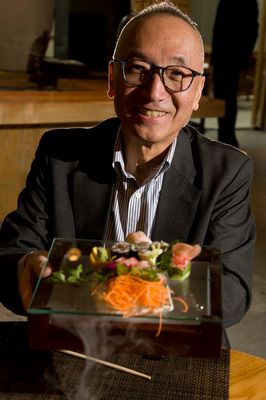Takayuki Kitagawa is a die-hard fan of robatayaki. If there is anything in the world more enjoyable than robatayaki, it is the art of making it, says the consul general of Japan in Bengaluru. “The fireside cooking, where the meats and vegetables are grilled over a charcoal grill, is nothing less than an art,” says Kitagawa, with a glint in his eyes.
Kitagawa is a regular at Edo Japanese Restaurant and Bar at ITC Gardenia, Bengaluru. He loves sitting right in front of the grills. The restaurant offers an array of robata-grilled items including negima (chicken and leeks skewers), buta enoki maki (enoki mushrooms wrapped in thinly sliced pork belly), nasu (eggplant) and shiitake (a meaty, flavoured mushroom). Kitagawa’s favourite, however, is gindara misozuke—miso-marinated black cod, full of Omega-3 fatty acids. The robata-style grilling makes the skin crispy and the flesh flaky and moist.
Robata brings back memories, says the 62-year-old. While in Tokyo, he used to be a regular at a yakitori shop near the railway station. “It was one of those places where even a broke middle-class worker could have robata and saké to his heart’s content,” he says. Kitagawa quit drinking a few years ago. However, whenever he visits Edo, he takes a long look at the well-stocked bar, which showcases bottles of saké.
Kitagawa grew up in a typical middle-class Japanese home. “As a child, my favourite food was beef steak. I liked crab meat too, but my parents would never buy me that. Instead of meat, we would have fish sausages, which were less expensive,” he recalls. As Kitagawa’s mother was busy running a business, his grandmother did all the cooking. “She would make rice, boiled fish, curry and miso soup. Sometimes, she would make ramen and gyoza (dumplings).”
Kitagawa and his siblings would look forward to the Obon festival, when the spirits are believed to come back and visit their loved ones. “Obon is known as the Hungry Ghost’s Day,” he says. “My mom would make ohagi, a rice ball coated with sweetened red beans, and wagashi, a traditional Japanese sweet, to feed the souls.”
Kitagawa looks like a happy child as chuka kurage (jellyfish seasoned in sesame and soy), ika uni (sea urchin-flavoured cuttlefish) and sunomono (sliced octopus, mackerel and crab stick in pickled vinegar) are served. These are followed by tako wasabi, which leads to an interesting conversation between him and chef Amit Patra. Kitagawa is delighted to find that the wasabi plant, the paste of which is used to marinate the baby octopus, is fresh. “The wasabi grater is made of shark skin,” says Patra.
Kitagawa tells him that until the 18th century, the Japanese were nearly all vegetarians—they would eat rice, beans and vegetables. Buddhism and Shintoism played a huge role in promoting vegetarianism. However, the eating habits changed drastically about 150 years ago as they came into contact with the western world.
I ask the consul general to pick restaurants in Bengaluru for authentic Japanese food. “Edo and Harima top my list,” he says. “I like Matsuri in Chancery Pavillion, Mikusu in Conrad, Yataii and Azuki as well. Then there are multicuisine restaurants like 1Q1 and Shiro that offer authentic Japanese food.” Edo’s set menu is very reasonably priced, says Kitagawa. The non-veg set menu costs Rs1,500.
A Japanese meal is incomplete without sushi and sashimi. Edo offers a range of sashimi—from sweet shrimp to yellowtail fish. “I eat a lot of sushi,” confesses Kitagawa.
The lingering nutty flavour of the kurogoma (black sesame) ice cream marks the end of our culinary rendezvous.



